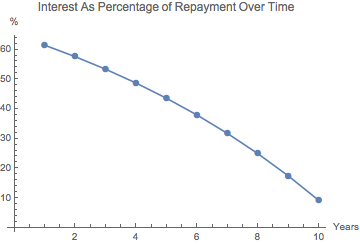Judging from this webpage, BeSmartee Reverse Loan Amortization Schedule, less is paid towards principal in the beginning, so I will describe that calculation. (I am fairly sure there is no calculation in which more is paid towards principal at the beginning. It wouldn't make mathematical sense.)
The standard equation for calculating the loan repayment d is
d = (r (1 + r)^n s)/((1 + r)^n - 1)
where
s is the principal
d is the periodic payment
r is the periodic interest rate
n is the number of periods
For example
s = 1000
r = 10% pa
n = 10 years
d = (r (1 + r)^n s)/((1 + r)^n - 1) = 162.745
The equation for the balance b at the end of period x is derived from
b[x + 1] = b[x] (1 + r) - d where b[0] = s giving
b[x] = (d - d (1 + r)^x + r (1 + r)^x s)/r
So, for example, for the balance at the end of year 5
x = 5
balance = (d - d (1 + r)^x + r (1 + r)^x s)/r = 616.933
The interest charged in year 6 will be 10% of that, 61.6933.
The repayments are 162.745 so the interest in year 6 is 37.9% of it.
Plotted below are the interest percentages over the term of the example loan.

Related question: https://money.stackexchange.com/a/86499/11768

